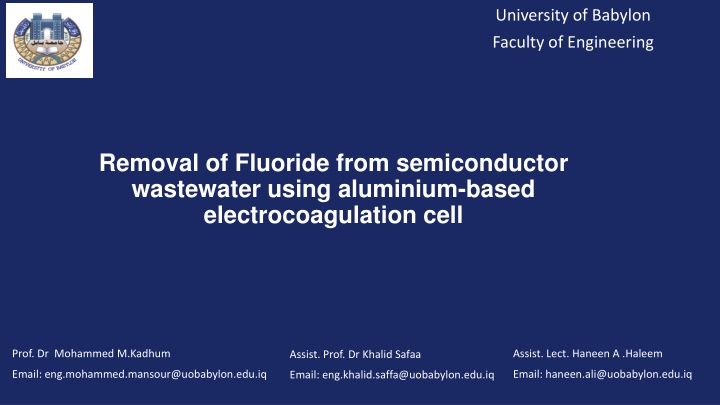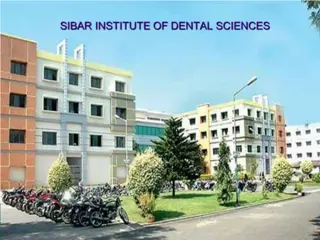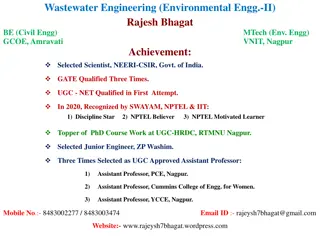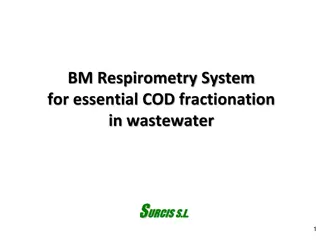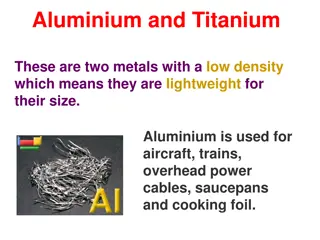Removal of Fluoride from Semiconductor Wastewater Using Aluminium-Based Electrocoagulation Cell
The study conducted at the University of Babylon Faculty of Engineering explores the efficient removal of fluoride from semiconductor wastewater through the application of an aluminium-based electrocoagulation method. Semiconductor manufacturing processes generate wastewater contaminated with various pollutants, posing risks to the environment and human health. The research optimizes the electrocoagulation process by adjusting parameters such as initial pH, electrode distance, and current density, achieving up to 97% fluoride removal. This innovative method offers a cost-effective and environmentally friendly solution for treating semiconductor wastewater.
Download Presentation

Please find below an Image/Link to download the presentation.
The content on the website is provided AS IS for your information and personal use only. It may not be sold, licensed, or shared on other websites without obtaining consent from the author.If you encounter any issues during the download, it is possible that the publisher has removed the file from their server.
You are allowed to download the files provided on this website for personal or commercial use, subject to the condition that they are used lawfully. All files are the property of their respective owners.
The content on the website is provided AS IS for your information and personal use only. It may not be sold, licensed, or shared on other websites without obtaining consent from the author.
E N D
Presentation Transcript
University of Babylon Faculty of Engineering Removal of Fluoride from semiconductor wastewater using aluminium-based electrocoagulation cell Prof. Dr Mohammed M.Kadhum Assist. Lect. Haneen A .Haleem Assist. Prof. Dr Khalid Safaa Email: eng.mohammed.mansour@uobabylon.edu.iq Email: haneen.ali@uobabylon.edu.iq Email: eng.khalid.saffa@uobabylon.edu.iq
University of Babylon Faculty of Engineering Abstract The current study employed the electrocoagulation (EC) method to remove fluoride from simulated semiconductor wastewater. The EC cell was supplied with three pairs of aluminium electrodes with an effective area of 120 cm2, and the removal of fluoride was optimised for the effects of the initial pH (3, 6 and 9), the distance between electrodes (3, 6 and 9 mm) and current density (2, 4 and 6 mA/cm2). The results obtained demonstrated the good efficiency of the aluminium-based EC cell; it removed as high as 97% of the fluoride within the first 20 minutes of treatment at a pH of 6, distance between electrodes of 3 mm and current density of 6 mA/cm2. Therefore, it could be concluded that the aluminium-based EC cell is a potential alternative to the conventional treatment methods.
University of Babylon Faculty of Engineering Introduction Semiconductor wastewater refers to the contaminated water generated during the manufacturing processes of semiconductors, which are fundamental components of electronic devices like computers, smartphones, and integrated circuits. Semiconductor manufacturing involves various complex processes such as photolithography, chemical etching, ion implantation, and chemical vapor deposition. These processes often require the use of a wide range of chemicals, including acids, solvents, and various other materials, which contribute to the contamination of wastewater with a wide range of pollutants, such as arsenic, fluoride, phosphate, sulphate, lead, cadmium, and various organic chemicals. Thus, improper disposal or treatment of semiconductor wastewater can lead to pollution of water bodies, soil, and even the atmosphere. The chemicals and heavy metals in this wastewater can have adverse effects on ecosystems and human health.
University of Babylon Faculty of Engineering Introduction Nowadays, various treatment technologies, such as chemical precipitation, ion exchange, reverse osmosis, and activated carbon filtration, are used to treat their wastewater. However, the majority of these technologies are either expensive, such as the reverse osmosis, or involves chemical additions , such as chemical precipitation. Thus, there is a need for reliable, affordable and efficient water treatment method to treat this type of wastewaters. In this context, this study aims at applying the EC method to remove fluoride from semiconductor wastewater. The EC method was used due to its ease of operating, affordability and safety.
University of Babylon Faculty of Engineering Materials and Methods Simulated wastewater: (The simulation process was carried out according to the procedures stated by Aoudj et al., 2017.) The preparation process started by diluting of 1 N of Hydrofluoric acid stock solution in deionised water and then reacted with lime. Finally, measured amounts of ammonia and Sodium Dodecyl sulphate were also added to the simulated solution. The latter was then subjected to a rapid mixing at 400 rpm for 2 minuets, the pH was adjusted to the desired value and moderately stirred (200 rpm) for 30 min. The solution was, then, immediate transferred to the EC cell. Fluoride concentration was measured using Hach-Lange fluoride cuvettes test (LCK323) and a Hach-Lange spectrophotometer (Model: DR 2800). Aoudj, S., Khelifa, A. and Drouiche, N., 2017. Removal of fluoride, SDS, ammonia and turbidity from semiconductor wastewater by combined electrocoagulation electroflotation. Chemosphere, 180, pp.379-387.
University of Babylon Faculty of Engineering Materials and Methods EC Cell The EC cell is shown in Fig. 1. The required current density was supplied Solution using a DC rectifier (HQ Power; Model: PS 3010). Aluminium electrodes The experimental conditions were: Initial pH (3, 6 and 9) Distance between electrodes (3, 6 and 9 mm) Current density (2, 4 and 6 mA/cm2). Fig. 1: The EC cell.
University of Babylon Faculty of Engineering Results Effects of the initial pH The best pH was 3,as shown in Fig. 2. However, pH 6 was used because the difference in the removal efficiency at pH 3 and 6 was not significant. Also, to avoid high additions of acids Fig. 2: Effects of the initial pH on fluoride removal
University of Babylon Faculty of Engineering Results Effects of the distance between electrodes The best distance was 3 mm, as shown in Fig. 3. Therefore, it was used in the rest of experiments. Fig. 3: Effects of distance between electrodes on fluoride removal
University of Babylon Faculty of Engineering Results Effects of the current density The best current density was 6 mA/cm2,as shown in Fig. 4. Therefore, it was used in the rest of experiments. It can be seen that the removal efficiency was almost the same at times 20 and 25. Thus, the best treatment was considered as 20 minutes Fig. 4: Effects of the current density on fluoride removal
University of Babylon Faculty of Engineering Conclusion Experimentally, the ability of the new EC cell to remove fluoride from wastewater was investigated taking into consideration the effects of different operational parameters, including the initial pH, current density and inter-electrode distance. The results revealed that the fluoride removal could be enhanced by increasing either the current density or minimising the pH and/or the distance between electrodes. It was found that about 20 min was quite enough to meet the WHO requirements when the initial fluoride concentration was 10 mg/L. Therefore, the EC cell could be a cost-effective alternative to the traditional lab scale EC reactors. It is recommended to invistigate the effects of other parameters, such the solution temperature and mixing speed.
